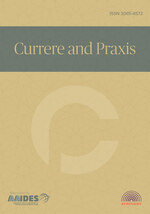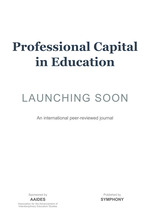Asking or answering questions: Musing over the educational strategy for the future
DOI:
https://doi.org/10.70116/298027411Keywords:
Asking questions, answering questions, evolution of human cognition, educational cognitivism, Chinese educational modelAbstract
Mainstream education systems are largely heavily based on checking students' knowledge by asking them questions and checking their answers. This is the complete reversal of the natural way of developing children’s brains from early age—through asking questions themselves. This article discusses the evolutionary importance of the ability of asking questions for human intelligence and its potential for creating a new strategy of education, based on encouraging students' natural curiosity, and encouraging their natural ability to search for knowledge. The article proposes that the most natural way to develop young human brains is through asking questions to adults from a very young age, the strategy developed and honed during the evolution of Homo sapiens through natural selection. The article concludes with some concrete classroom strategies and play suggestions that can be used to encourage young learners to ask questions freely in both child-centered education (CCE) and more traditional teacher-centered education models.
Downloads
References
Astington, J. W., & Gopnik, A. (1991). Theoretical explanations of children's understanding of the mind. British Journal of Developmental Psychology, 9(1), 7-31.
Bero, T. (2023). Turns out, Harvard students aren’t that smart after all. The Guardian. Retrieved March 9, 2023, from theguardian.com/commentisfree/2021/nov/17/harvard-university-students-smart-iq
Berwick, I. (2011). Review: Battle hymn of the tiger mother. Retrieved March 13, 2023, https://www.theguardian.com/books/2011/jan/29/tiger-mother-amy-chua-review
Brodie, K., Lelliott, A., & Davis, H. (2002). Forms and substance in learner-centred teaching: Teachers’ take-up from an in-service programme in South Africa. Teaching and teacher Education, 18(5), 541-559.
Bronowski, J., & Bellugi, U. (1980). Language, name and concept. In T. A. Sebeok & J. Umiker-Sebeok (Eds.), Speaking of apes: A critical anthology of two-way communication with man (pp. 103-113). Plenum Press.
Brown, R. (1968). The development of wh questions in child speech. Journal of Verbal Learning and Verbal Behavior, 7(2), 279-290.
Butler, L. P., Ronfard S., & Corriveau, K. H. (Eds.) (2020). The questioning child: Insights from psychology and education. Cambridge University Press.
Chan, Wing-Tsit. (1963). A source book in Chinese philosophy (Trans. Wing-Tsit Chan). Princeton University Press.
Chen, C. (2012). Asians: Too smart for their own good? The New York Times. Retrieved March 1, 2023, https://www.nytimes.com/2012/12/20/opinion/asians-too-smart-for-their-own-good.html
Chen, J. L. (1995). The internalization of the model minority stereotype as a predictor of depression among Chinese-Americans (Unpublished doctoral dissertation). California School of Professional Psychology, Los Angeles.
Chichekian, T., & Shore, B. M. (2016). Preservice and practicing teachers’ self-efficacy for inquiry-based instruction. Cogent Education, 3(1), 1236872.
Chouinard, M. M., Harris, P. L., & Maratsos, M. P. (2007). Children's questions: A mechanism for cognitive development. III. Diary study of children's questions. Monographs of the Society for Research in Child Development, 72(1), 45–57.
Cremin, T., Glauert, E., Craft, A., Compton, A., & Stylianidou, F. (2015). Creative little scientists: Exploring pedagogical synergies between inquiry-based and creative approaches in early years science. Education 3-13, 43(4), 404-419.
Crystal, D. (1987). The Cambridge encyclopaedia of language. Cambridge University Press.
Da Vinci, L. (Quotes). Retrieved March 7, 2023, https://www.brainyquote.com/quotes/leonardo-da_vinci_542476
Darwin, C. R. (1872). The expression of the emotions in man and animals. John Murray.
Davis, E. A. (1932). The form and function of children’s questions. Child Development, 3(1), 57–74.
De Laguna, G. A., (1963). Speech, its function and development. Indiana University Press.
Dejonckheere, P. J. N., De Wit, N. L., Van de Keere, K. V., & Vervaet, S. (2016). Exploring the classroom: Teaching science in early childhood. European Journal of Educational Research, 5(3), 149-164.
Donaldson, S. R. (Quotes). Retrieved February 21, 2023, https://www.azquotes.com/quote/566447
Einstein, A. (Quotes). Retrieved February 19, 2023, https://www.goodreads.com/quotes/20604-the-important-thing-is-not-to-stop-questioning-curiosity-has
Ferguson, C. A. (1977). Baby talk as a simplified register. In C. E. Snow & C. A. Ferguson (Eds.), Talking to children (pp. 219-235). Cambridge University Press.
Finland remains among top nations in PISA education survey. Retrieved February 27, 2023, https://finland.fi/life-society/finland-remains-among-top-nations-in-pisa-education-survey/
Forbes, M. (Quotes). Retrieved February 14, 2023, https://www.goodreads.com/quotes/3338-the-purpose-of-education-is-to-replace-an-empty-mind
Freier, P. (1970). Pedagogy of the oppressed. Seabury Press.
Freud, S. (Quotes). Retrieved February 14, 2023, https://www.brainyquote.com/quotes/sigmund_freud_106066
Gardner, B. T., & Gardner, R. A. (1975). Evidence for sentence constitutents in the early utterances of child and chimpanzee. Journal of Experimental Psychology: General, 104(3), 244.
Gardner, R. A., & Gardner, B. T. (1969). Teaching sign language to a chimpanzee: A standardized system of gestures provides a means of two-way communication with a chimpanzee. Science, 165(3894), 664-672.
Gopnik, A. (2012). Scientific thinking in young children: Theoretical advances, empirical research, and policy implications. Science, 337(6102), 1623–1627.
Graue E. (2005). (De)centering the kindergarten prototype in the child-centred classroom. In Ryan S. & Grieshaber S. (Eds.), Practical transformations and transformational practices: Globalization, postmodernism, and early childhood education (pp. 39-58). Elsevier.
Greenfield, P. M., & Savage-Rumbaugh, E. S. (1993). Comparing communicative competence in child and chimp: The pragmatics of repetition. Journal of Child Language, 20(1), 1-26.
Greenfield, P.M., & Savage-Rumbaugh S. (1990). Grammatical combination in Pan paniscus: processes of learning and invention in the evolution and development of language. In S. T. Parker & K. R. Gibson (Eds.), Language and intelligence in monkeys and apes: Comparative developmental perspectives (pp. 540–578). Cambridge University Press.
Guthrie, G. (1990). In the defense of formalistic teaching. In Rust, V. D. & Dalin, P. (Eds.), Teachers and teaching in the developing world (pp. 219-232). Garland Publishers.
Harris, P. L. (2020). The point, the Shrug, and the question of clarification. In Butler, L. P., Ronfard S., & Corriveau, K. H. (Eds.), The questioning child: Insights from psychology and education (pp. 29-50). Cambridge University Press.
Harris, P. L. (2022). Young children share imagined possibilities: evidence for an early-emerging human competence. Philosophical Transactions of the Royal Society B, 377(1866), 20220022.
Harwood, D., Bajovic, M., Woloshyn, V., Di Cesare, D. M., Lane, L., & Scott, K. (2015). Intersecting spaces in early childhood education: Inquiry-based pedagogy and tablets. The International Journal of Holistic Early Learning and Development, 1, 53-67.
Hatoff, Q. (2012). Donning a mask: Suicide at Harvard. The Harvard Crimson. Retrieved February 26, 2023, https://www.thecrimson.com/article/2012/12/10/suicide-harvard-mental-health/
Hocket, C. F. (1959). Animal ‘Languages’ and human language. In J. N. Spuhler (Ed.), The evolution of man's capacity for culture (pp. 32-39). Wayne State University Press.
Hockett, C. F., & Archer, R. (1964). The human revolution. Current Anthropology, 5, 135-168.
Holliday, A. (1994). Appropriate methodology and social context. Cambridge University Press.
Isaacs, S. S. (1930). The intellectual growth of young children. Routledge and Kegan Paul.
Jensen, B., Hunter, A., Sonnemann, J., & Burns, T. (2012). Catching up: Learning from the best school systems in East Asia, Grattan Institute. Retrieved February 8, 2023, https://core.ac.uk/download/pdf/30679884.pdf
Jones, L. (2007). The student-centered classroom. Cambridge University Press.
Jordania, J. (2006). Who asked the first question? Origins of human choral singing, intelligence, language and speech. Tbilisi State University Press.
Jordania, J. (2011). Should we teach students how to answer questions or how to ask questions? Towards a new educational strategy. Sutra the thread, A Quarterly Journal for Research on Education, Psychology, Traditional Sciences and Systems, Health and Consciousness. Vol. 8: 29-42. Materials of the International congress “Revisiting Education Culture Learning and Training Formats for Human Empowerment,” held in New Delhi, 14-18 January, 2010.
Kalinka, A. T., & Tomancak, P. (2012). The evolution of early animal embryos: conservation or divergence?. Trends in ecology & evolution, 27(7), 385-393.
Kao, G. (1995). Asian Americans as model minorities? A look at their academic performance. American Journal of Education, 103(2), 121–159.
Kao, G., & Thompson, J. S. (2003). Racial and ethnic stratification in educational achievement and attainment. Annual Review of Sociology, 29(1), 417-442.
Khalick, A-E, F., Lederman, N., & Schwartz, R. (2015). Inquiry, as a curriculum strand. Encyclopedia of science education (pp. 510-514). Springer.
Kurkul, K. E., & Corriveau, K. H. (2018). Question, explanation, follow‐up: A mechanism for learning from others?. Child Development, 89(1), 280-294.
Lea, S. J., Stephenson, D., & Troy, J. (2003). Higher education students' attitudes to student-centred learning: beyond'educational bulimia'?. Studies in Higher Education, 28(3), 321-334.
Lee, I-F. (2018). Child-centered learning. In Shackelford, T., & Weekes-Shackelford, V. (Eds.), Encyclopedia of evolutionary psychological science. Springer, Cham. Retrieved March 1, 2023, https://doi.org/10.1007/978-3-319-16999-6_2439-1
MacDonald, K. (2016). Back to the garten: Inquiry-based learning in an outdoor kindergarten classroom (Unpublished masters’ thesis). Faculty of Social Sciences, Brock University, St. Catherines, Ontario.
Matthews, W. J. (2003). Constructivism in the classroom: Epistemology, history, and empirical evidence. Teacher Education Quarterly, 30(3), 51-64.
McDougall, B. (2014). Principals call for a national standard school starting age of five-and-a-half. August 29, 2014. News. Daily Telegraph, Sydney.
McNeill, D. (1980). Sentence structure in chimpanzee communication. In T. A. Sebeok & J. Umiker-Sebeok (Eds.), Speaking of apes: A critical anthology of two-way communication with man (pp. 150-156). Plenium Press.
Minner, D., Levy, A., & Century, J. (2009). Inquiry‐based science instruction. What is it and does it matter? Results from a research synthesis year 1984 to 2002. Journal of Research in Science Teaching, 47(4), 474-496.
Moskowitz, B. A. (1978). The acquisition of language. Scientific American, 239(5), 92-109.
National Research Council. (2000). Inquiry and the National Science Education Standards: A guide for Teaching and Learning. National Academy Press. Retrieved March 2, 2023, https://www.nap.edu/read/9596/chapter/1#xi.
Norquay, N. (1999). Social difference and the problem of the ‘unique individual’: An uneasy legacy of child-centred pedagogy. Canadian Journal of Education, 24(2)183-196.
O'Donoghue, T. A. (1994). The need for educational reform and the role of teacher training: An alternative perspective. International Journal of Educational Development, 14(2), 207-210.
Oelkers, J. (2002). Rousseau and the image of modern education. Journal of Curriculum Studies, 34(6), 679-698.
O'Sullivan, E. (2003). Bringing a perspective of transformative learning to globalized consumption. International Journal of Consumer Studies, 27(4), 326-330.
Piaget, J. (1936). The origin of intelligence in the child. Routledge & Kegan Paul.
Pisa Records by Country. (2023). Retrieved March 4, 2023, https://worldpopulationreview.com-/country-rankings/pisa-scores-by-country
Premack, A. J., & Premack, D. (1972). Teaching language to an ape. Scientific American, 227(4), 92-99.
Premack, D., & Premack, A. J. (1983). The mind of an ape. W.W. Norton & Company.
Revesz, G. (1956). The origin and prehistory of language. Longmans, Green and Co.
Rivas, E. (2005). Recent use of signs by chimpanzees (Pan Troglodytes) in interactions with humans. Journal of Comparative Psychology, 119(4), 404.
Rodgers, C. R. (2002). Seeing student learning: Teacher change and the role of reflection. Harvard Educational Review, 72(2), 230.
Roessler, J. (2013). Knowledge, causal explanation, and teleology. In T. S. Gendler & J. Hawthorne (Eds.), Oxford studies in epistemology volume 4, (pp. 321–332). Retrieved February 18, 2023, https://academic.oup.com/book/274/chapter-abstract/134840263?redirectedFrom=fulltext
Russel, B. B. (Quotes). Retrieved March 10, 2023, https://www.brainyquote.com/authors/bertrand-russell-quotes
Savage-Rumbaugh, E. S., & Lewin, R. (1994). Kanzi: The ape at the brink of the human mind. John Wiley & Sons, Inc.
Schaller, G. B. (1972). The serengeti lion: A study of predator-prey relations. University of Chicago Press.
Serrant, L. (2020). How well do you listen? Plutarch and his letter on listening. Retrieved March 3, 2023, https://classicalwisdom.com/people/historians/how-well-do-you-listen-plutarch-and-his-letter-on-listening/
Shah, P. E., Weeks, H. M., Richards, B., & Kaciroti, N. (2018). Early childhood curiosity and kindergarten reading and math academic achievement. Pediatric Research, 84(3), 380-386.
Shah, R. K. (2019). Child-centered education: Criticisms. Shanlax International Journal of Education, 8(1), 22–37.
Simler, K., & Hanson, R. (2018). The elephant in the brain: Hidden motives in everyday life. Oxford University Press.
Simon, B. (1981). The primary school revolution: Myth or reality? In B. Simon & J. Willcocks (Eds.), Research and practice in the primary classroom. Routledge & Kegan Paul.
Singer, E. (2005). The liberation of the child: A recurrent theme in the history of education in western societies. Early Child Development and Care, 175(6), 611-620.
Skelton, C. (2002). The feminisation of schooling or re-masculinising primary education?. International Studies in Sociology of Education, 12(1), 77-96.
Smith, S. (2013). 'Too much, too soon': Children should not start school until age six or seven, say education experts. Retrieved February 14, 2023, http://www.dailymail.co.uk/news/article-2418281/Children-start-school-age-seven-say-education-experts.html#ixzz3MfEqS1Th
Stacey, S. (2018). Inquiry-based early learning environments: Creating, supporting, and collaborating. Redleaf Press.
Starr, D. (2012). China and the Confucian education model. Universitas, 21(1), 1-27.
Stone, J. E. (1996). Developmentalism: An obscure but pervasive restriction on educational improvement. Education Policy Analysis Archives, 4(8), 1-32.
Sully, J. (1896/2000). Studies of childhood. D. Appleton.
Tabulawa, R. (2003). International aid agencies, learner-centred pedagogy and political democratisation: A critique. Comparative education, 39(1), 7-26.
Terrace, H. S. (1980). Nim. Eyre Methuen.
Thompson, L. H. (1924). Children's questions. Educational Research Bulletin, 3(16), 347-352.
Tizard, B., & Hughes M. (1984). Young children learning. Harvard University Press.
Vygotsky, L. (1978). Mind in society: The development of higher psychological processes. Harvard University Press.
Walkerdine, V. (1985). On the regulation of speaking and silence: Subjectivity, class, and gender in contemporary schooling. In C. Steedman, C. Urwin, & V. Walkerdine (Eds.), Language, gender, and childhood (pp. 203-241). Routledge & Kegan Paul.
Walkerdine, V. (1990). Schoolgirl fictions. Verso Books.
Wills, C. (1993). The runaway brain: The evolution of human uniqueness. Basic Books.
Wimmer, H., & Perner, J. (1983). Beliefs about beliefs: Representation and constraining function of wrong beliefs in young children's understanding of deception. Cognition, 13(1), 103-128.
Wise, S. M. (2002). Drawing the line. Perseus Books.
Yefremova. A. (2023). Demystifying math 55. Retrieved February 20, 2023, https://www.math.harvard.edu/demystifying-math-55/
Downloads
Published
How to Cite
Issue
Section
License
Copyright (c) 2023 Symphony

This work is licensed under a Creative Commons Attribution 4.0 International License.














